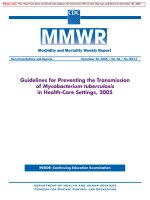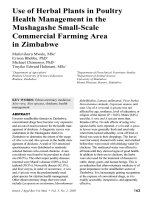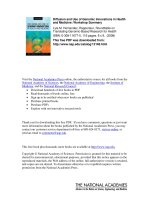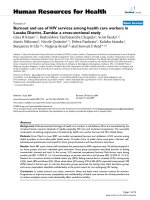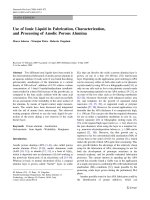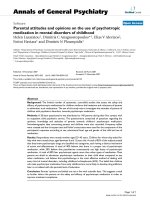Diffusion and Use of Genomic Innovations in Health and Medicine: Workshop Summary pot
Bạn đang xem bản rút gọn của tài liệu. Xem và tải ngay bản đầy đủ của tài liệu tại đây (784.76 KB, 117 trang )
Visit the
National Academies Press online, the authoritative source for all books from the
National Academy of Sciences, the National Academy of Engineering, the Institute of
Medicine, and the National Research Council:
• Download hundreds of free books in PDF
• Read thousands of books online, free
• Sign up to be notified when new books are published
• Purchase printed books
• Purchase PDFs
• Explore with our innovative research tools
Thank you for downloading this free PDF. If you have comments, questions or just want
more information about the books published by the National Academies Press, you may
contact our customer service department toll-free at 888-624-8373,
visit us online, or
send an email to
This free book plus thousands more books are available at
.
Copyright © National Academy of Sciences. Permission is granted for this material to be
shared for noncommercial, educational purposes, provided that this notice appears on the
reproduced materials, the Web address of the online, full authoritative version is retained,
and copies are not altered. To disseminate otherwise or to republish requires written
permission from the National Academies Press.
ISBN: 0-309-11677-5, 116 pages, 6 x 9, (2008)
This free PDF was downloaded from:
/>Diffusion and Use of Genomic Innovations in Health
and Medicine: Workshop Summary
Lyla M. Hernandez, Rapporteur, Roundtable on
Translating Genomic-Based Research for Health
Copyright © National Academy of Sciences. All rights reserved.
Diffusion and Use of Genomic Innovations in Health and Medicine: Workshop Summary
/>Lyla M. Hernandez, Rapporteur
Roundtable on Translating Genomic-Based Research for Health
Board on Health Sciences Policy
Diffusion anD use of
Genomic innovations
in HealtH anD MeDicine
workshop summary
Copyright © National Academy of Sciences. All rights reserved.
Diffusion and Use of Genomic Innovations in Health and Medicine: Workshop Summary
/>THE NATIONAL ACADEMIES PRESS 500 Fifth Street, N.W. Washington, DC 20001
NOTICE: The project that is the subject of this report was approved by the Governing
Board of the National Research Council, whose members are drawn from the councils of
the National Academy of Sciences, the National Academy of Engineering, and the Institute
of Medicine. The members of the committee responsible for the report were chosen for their
special competences and with regard for appropriate balance.
This project was supported by contracts between the National Academy of Sciences and
American College of Medical Genetics (Unnumbered contract); American College of Physicians
(Unnumbered contract); American Medical Association (Unnumbered contract); AstraZeneca
Pharmaceuticals, Inc. (Unnumbered contract); Blue Cross/Shield Association (Unnumbered
contract); Centers for Disease Control and Prevention (CDC) (Contract No. 200-2005-13434);
College of American Pathologists (Unnumbered contract); Department of Veterans Affairs (VA)
(Contract No. V101(93) P-2238); Eli Lilly and Company (Contract No. LRL-0028-07); Food
& Drug Administration (Contract No. 223012460); Genetic Alliance (Unnumbered contract);
Genomics Health, Inc. (Unnumbered contract); GlaxoSmithKline, Inc. (Unnumbered contract);
Health Systems Research, Inc. (Contract No. 07-H0116); National Human Genome Research
Institute (Contract No. N01-OD-4-2139, TO#189); National Institute of Child Health and
Human Development (Contract No. N01-OD-4-2139, TO#189); National Society of Genetic
Counselors (Unnumbered contract); Secretary’s Advisory Committee on Genetics, Health and
Society (Contract No. N01-OD-4-2139, TO#189); and United Health Care (Unnumbered
contract). Any opinions, findings, conclusions, or recommendations expressed in this publica-
tion are those of the author(s) and do not necessarily reflect the views of the organizations or
agencies that provided support for the project.
International Standard Book Number-13: 978-0-309-11676-3
International Standard Book Number-10: 0-309-11676-7
Additional copies of this report are available from the National Academies Press, 500 Fifth
Street, N.W., Lockbox 285, Washington, DC 20055; (800) 624-6242 or (202) 334-3313 (in
the Washington metropolitan area); Internet, .
For more information about the Institute of Medicine, visit the IOM home page at: www.
iom.edu.
Copyright 2008 by the National Academy of Sciences. All rights reserved.
Printed in the United States of America
The serpent has been a symbol of long life, healing, and knowledge among almost all cultures
and religions since the beginning of recorded history. The serpent adopted as a logotype by
the Institute of Medicine is a relief carving from ancient Greece, now held by the Staatliche
Museen in Berlin.
Suggested citation: IOM (Institute of Medicine). 2008. Diffusion and use of genomic innovations
in health and medicine: Workshop summary. Washington, DC: The National Academies Press.
Copyright © National Academy of Sciences. All rights reserved.
Diffusion and Use of Genomic Innovations in Health and Medicine: Workshop Summary
/>“Knowing is not enough; we must apply.
Willing is not enough; we must do.”
—Goethe
Advising the Nation. Improving Health.
Copyright © National Academy of Sciences. All rights reserved.
Diffusion and Use of Genomic Innovations in Health and Medicine: Workshop Summary
/>The National Academy of Sciences is a private, nonprofit, self-perpetuating society
of distinguished scholars engaged in scientific and engineering research, dedicated to
the furtherance of science and technology and to their use for the general welfare.
Upon the authority of the charter granted to it by the Congress in 1863, the Acad-
emy has a mandate that requires it to advise the federal government on scientific
and technical matters. Dr. Ralph J. Cicerone is president of the National Academy
of Sciences.
The National Academy of Engineering was established in 1964, under the charter
of the National Academy of Sciences, as a parallel organization of outstanding
engineers. It is autonomous in its administration and in the selection of its members,
sharing with the National Academy of Sciences the responsibility for advising the
federal government. The National Academy of Engineering also sponsors engineer-
ing programs aimed at meeting national needs, encourages education and research,
and recognizes the superior achievements of engineers. Dr. Charles M. Vest is presi-
dent of the National Academy of Engineering.
The Institute of Medicine was established in 1970 by the National Academy of
Sciences to secure the services of eminent members of appropriate professions in
the examination of policy matters pertaining to the health of the public. The Insti-
tute acts under the responsibility given to the National Academy of Sciences by its
congressional charter to be an adviser to the federal government and, upon its own
initiative, to identify issues of medical care, research, and education. Dr. Harvey V.
Fineberg is president of the Institute of Medicine.
The National Research Council was organized by the National Academy of Sci-
ences in 1916 to associate the broad community of science and technology with the
Academy’s purposes of furthering knowledge and advising the federal government.
Functioning in accordance with general policies determined by the Academy, the
Council has become the principal operating agency of both the National Academy
of Sciences and the National Academy of Engineering in providing services to
the government, the public, and the scientific and engineering communities. The
Council is administered jointly by both Academies and the Institute of Medicine.
Dr. Ralph J. Cicerone and Dr. Charles M. Vest are chair and vice chair, respectively,
of the National Research Council.
www.national-acade mies.org
Copyright © National Academy of Sciences. All rights reserved.
Diffusion and Use of Genomic Innovations in Health and Medicine: Workshop Summary
/>v
PLANNING COMMITTEE ON DIFFUSION AND USE OF
GENOMIC INNOVATIONS IN HEALTH AND MEDICINE
*
WYLIE BURKE, M.D., Ph.D. (Chair), Professor and Chair, Department
of Medical History and Ethics, University of Washington, Seattle
NAOMI ARONSON, Ph.D., Executive Director, Technology Evaluation
Center, BlueCross/BlueShield Association, Chicago, Illinois
MOHAMED KHAN, M.D., Ph.D., Associate Director of Translational
Research, Department of Radiation Medicine, Roswell Park Cancer
Institute, Buffalo, New York
STEPHEN G. RYAN, M.D., Executive Director, Discovery Medicine and
Epidemiology, AstraZeneca Pharmaceuticals, Wilmington, Delaware
KEVIN SCHULMAN, M.D., Professor of Medicine and Business
Administration, Director, Center for Clinical and Genetic Economics,
Associate Director, Duke Clinical Research Institute, Duke University
School of Medicine, Durham, North Carolina
JANET WOODCOCK, M.D., Deputy Commissioner and Chief Medical
Officer, Food & Drug Administration, Bethesda, Maryland
*
IOM planning committees are solely responsible for organizing the workshop, identifying
topics, and choosing speakers. The responsibility for the published workshop summary rests
with the workshop rapporteur and the institution.
Copyright © National Academy of Sciences. All rights reserved.
Diffusion and Use of Genomic Innovations in Health and Medicine: Workshop Summary
/>vi
ROUNDTABLE ON TRANSLATING
GENOMIC-BASED RESEARCH FOR HEALTH
*
WYLIE BURKE, M.D., Ph.D. (Chair), Professor and Chair, Department
of Medical History and Ethics, University of Washington, Seattle
STEPHEN ECK, M.D., Ph.D., Vice President, Translational Medicine &
Pharmacogenomics, Eli Lilly and Company, Indianapolis, Indiana
FAITH T. FITZGERALD, M.D., Professor of Medicine, Assistant Dean
of Humanities and Bioethics, University of California, Davis Health
System, Sacramento
GEOFFREY GINSBURG, M.D., Ph.D., Director, Center for Genomic
Medicine, Institute for Genomic Sciences & Policy, Duke University,
Durham, North Carolina
ALAN E. GUTTMACHER, M.D., Deputy Director, National Human
Genome Research Institute, National Institues of Health, Bethesda,
Maryland
R. RODNEY HOWELL, M.D., Special Assistant to the Director,
National Institute of Child Health and Human Development,
Bethesda, Maryland
KATHY HUDSON, Ph.D., Director, Genetics and Public Policy Center,
Berman Bioethics Institute, Johns Hopkins University, Washington,
District of Columbia
SHARON KARDIA, Ph.D., Director, Public Health Genetic Programs,
Associate Professor, Department of Epidemiology, University of
Michigan, School of Public Health, Ann Arbor
MOHAMED KHAN, M.D., Ph.D., Associate Director of Translational
Research, Department of Radiation Medicine, Roswell Park Cancer
Institute, Buffalo, New York
MUIN KHOURY, M.D., Ph.D., Director, National Office of Public
Health Genomics, Centers for Disease Control and Prevention,
Atlanta, Georgia
ALLAN KORN, M.D., Chief Medical Officer, Senior Vice President
Clinical Affairs, BlueCross/BlueShield Association, Chicago, Illinois
DEBRA LEONARD, M.D., Ph.D., Professor and Vice Chair for
Laboratory Medicine, Director of the Clinical Laboratories for New
York-Presbyterian Hospital, Weill Cornell Medical Center of Cornell
University, New York
*
IOM forums and roundtables do not issue, review, or approve individual documents. The
responsibility for the published workshop summary rests with the workshop rapporteur and
the institution.
Copyright © National Academy of Sciences. All rights reserved.
Diffusion and Use of Genomic Innovations in Health and Medicine: Workshop Summary
/>vii
MICHELE LLOYD-PURYEAR, M.D., Ph.D., Chief, Genetic Services
Branch, Health Resources and Services Administration, Rockville,
Maryland
ROBERT L. NUSSBAUM, M.D., Chief, Division of Medical Genetics,
University of California, San Francisco, School of Medicine
TIMOTHY O’LEARY, M.D., Ph.D., Director, Biomedical Laboratory
Research and Development Service, Director, Clinical Science
Research and Development Service, Department of Veterans Affairs,
Washington, District of Columbia
AMELIE G. RAMIREZ, Dr.P.H., Dielmann Chair, Health Disparities
and Community Outreach Research, Director, Institute for Health
Promotion Research, University of Texas Health Science Center at
San Antonio
ALLEN D. ROSES, Ph.D., Jefferson-Pilot Professor of Neurobiology and
Genetics, Professor of Medicine (Neurology), Director, Deane Drug
Discovery Institute, Senior Scholar, Fuqua School of Business,
R. David Thomas Executive Training Center, Duke University,
Durham, North Carolina
STEPHEN G. RYAN, M.D., Executive Director, Discovery Medicine and
Epidemiology, AstraZeneca Pharmaceuticals, Wilmington, Delaware
KEVIN SCHULMAN, M.D., Professor of Medicine and Business
Administration, Director, Center for Clinical and Genetic Economics,
Associate Director, Duke Clinical Research Institute, Duke University
School of Medicine, Durham, North Carolina
PATRICK TERRY, Director, Consumer Advocacy and Government
Affairs, Genomic Health, Inc., Washington, District of Columbia
SHARON TERRY, President and CEO, Genetic Alliance, Washington,
District of Columbia
STEVEN TEUTSCH, M.D., Ph.D., Executive Director, U.S. Outcomes
Research, Merck & Co., Inc., West Point, Pennsylvania
MICHAEL S. WATSON, Ph.D., Executive Director, American College of
Medical Genetics, Bethesda, Maryland
CATHERINE A. WICKLUND, M.S., CGC, President, National Society
of Genetic Counselors, Associate Director, Graduate Program in
Genetic Counseling, Assistant Professor, Department of Obstetrics
and Gynecology, Northwestern University, Chicago, Illinois
JANET WOODCOCK, M.D., Deputy Commissioner and Chief Medical
Officer, Food & Drug Administration, Bethesda, Maryland
Copyright © National Academy of Sciences. All rights reserved.
Diffusion and Use of Genomic Innovations in Health and Medicine: Workshop Summary
/>viii
IOM Staff
LYLA M. HERNANDEZ, M.P.H., Project Director
ERIN HAMMERS, M.P.H., Research Associate
ALEX REPACE, B.S., Senior Project Assistant
IOM Anniversary Fellow
LISA BARCELLOS, Ph.D., Assistant Professor, University of California,
Berkeley
Copyright © National Academy of Sciences. All rights reserved.
Diffusion and Use of Genomic Innovations in Health and Medicine: Workshop Summary
/>ix
BOARD ON HEALTH SCIENCES POLICY
*
FRED H. GAGE, Ph.D. (Chair), Vi and John Adler Professor, Laboratory
of Genetics, The Salk Institute for Biological Studies, La Jolla,
California
C. THOMAS CASKEY, M.D., Director, Brown Foundation Institute of
Molecular Medicine for the Prevention of Human Diseases, University
of Texas, Houston Health Science Center
GAIL H. CASSELL, Ph.D., Vice President, Scientific Affairs and
Distinguished Lilly Research Scholar for Infectious Diseases, Eli Lilly
and Company, Indianapolis, Indiana
JAMES F. CHILDRESS, Ph.D., The John Allen Hollingsworth Professor
of Ethics, Professor of Medical Education and Director, Institute
for Practical Ethics, Department of Religious Studies, University of
Virginia, Charlottesville
ELLEN WRIGHT CLAYTON, J.D., M.D., Rosalind E. Franklin Professor
of Genetics and Health Policy, Professor of Law, Director, Genetics and
Health Policy Center, Vanderbilt University Medical School, Nashville,
Tennessee
LINDA C. GIUDICE, M.D., Ph.D., Professor and Chairman,
Departments of Obstetrics, Gynecology and Reproductive Services,
University of California, San Francisco
LYNN R. GOLDMAN, M.D., Johns Hopkins Bloomberg School of
Public Health, Baltimore, Maryland
LAWRENCE O. GOSTIN, J.D., Associate Dean for Research and
Academic Programs and Professor of Law, Director, Center on
Law and the Public’s Health, Georgetown University Law Center,
Washington, District of Columbia
MARTHA N. HILL, Ph.D., Dean and Professor of Nursing, Johns
Hopkins University School of Nursing, Baltimore, Maryland
DAVID KORN, M.D., Senior Vice President for Biomedical and Health
Sciences Research, Association of American Medical Colleges,
Washington, District of Columbia
ALAN LESHNER, Ph.D., CEO and Publisher of Science, American
Association for the Advancement of Science, Washington, District of
Columbia
JONATHAN D. MORENO, Ph.D., David and Lyn Silfen University
Professor, University of Pennsylvania, Philadelphia
*
IOM boards do not review or approve individual workshops and are not asked to endorse
conclusions and recommendations. The responsibility for the content of the summary rests
with the workshop rapporteur and the institution.
Copyright © National Academy of Sciences. All rights reserved.
Diffusion and Use of Genomic Innovations in Health and Medicine: Workshop Summary
/>x
E. ALBERT REECE, M.D., Ph.D., Vice President for Medical Affairs,
Dean, School of Medicine, University of Maryland School of
Medicine, Baltimore
LINDA ROSENSTOCK, M.D., M.P.H., Dean, School of Public Health,
University of California, Los Angeles
MICHAEL J. WELCH, Ph.D., Professor of Radiology, Co-Director,
Division of Radiological Sciences, Department of Radiology,
Washington University School of Medicine, St. Louis, Missouri
OWEN N. WITTE, M.D., Investigator, HHMI, President’s Chair in
Developmental Immunology, David Geffen School of Medicine,
University of California, Los Angeles
IOM Staff
ANDREW M. POPE, Ph.D., Director
AMY HAAS, Board Assistant
DONNA RANDALL, Financial Officer
Copyright © National Academy of Sciences. All rights reserved.
Diffusion and Use of Genomic Innovations in Health and Medicine: Workshop Summary
/>xi
This report has been reviewed in draft form by individuals chosen
for their diverse perspectives and technical expertise, in accordance with
procedures approved by the National Research Council’s Report Review
Committee. The purpose of this independent review is to provide candid
and critical comments that will assist the institution in making its published
report as sound as possible and to ensure that the report meets institutional
standards for objectivity, evidence, and responsiveness to the study charge.
The review comments and draft manuscript remain confidential to protect
the integrity of the deliberative process. We wish to thank the following
individuals for their review of this report:
Geoffrey Ginsburg, M.D., Ph.D., Director, Institute for Genomic
Sciences & Policy, Duke University, Durham, North Carolina
David R. Nerenz, Ph.D., Director, Center for Health Services
Research, Henry Ford Health System, Detroit, Michigan
Bernard M. Rosof, M.D., Senior Vice President for Health Affairs,
North Shore-Long Island Jewish Health, Great Neck, New York
Sandra Suther, Ph.D., Assistant Professor, Behavioral Science &
Health Education, Institute of Public Health, Florida A&M
University, Tallahassee, Florida
Although the reviewers listed above have provided many constructive
comments and suggestions, they were not asked to endorse the final draft
of the report before its release. The review of this report was overseen by
Reviewers
Copyright © National Academy of Sciences. All rights reserved.
Diffusion and Use of Genomic Innovations in Health and Medicine: Workshop Summary
/>xii REVIEWERS
Bradford H. Gray, Ph.D., Editor, The Milbank Quarterly, Principal Research
Associate, The Urban Institute. Appointed by the Institute of Medicine, he
was responsible for making certain that an independent examination of this
report was carried out in accordance with institutional procedures and that
all review comments were carefully considered. Responsibility for the final
content of this report rests entirely with the author and the institution.
Copyright © National Academy of Sciences. All rights reserved.
Diffusion and Use of Genomic Innovations in Health and Medicine: Workshop Summary
/>xiii
Contents
1 INTRODUCTION 1
2 TRANSLATION OF INNOVATIONS 3
A Broad Perspective, 3
Robert M. Califf, M.D., MACC
Understanding Types of Innovation and Implications for Policy, 12
Kevin Schulman, M.D.
Lessons for Genomics from Other Technologies, 16
Annetine Gelijns, Ph.D.
Discussion, 21
Wylie Burke, M.D., Ph.D.
3 PRACTICAL INCENTIVES AND BARRIERS TO
TRANSLATION 25
Translating Medical Innovations with Appropriate Evidence, 25
Sean Tunis, M.D., M.Sc.
Assessing Technology for Use in Health and Medicine, 29
Naomi Aronson, Ph.D.
Integrating Genetic Technology into a Health Care System, 33
Wylie Burke, M.D., Ph.D.
View from the Trenches: Challenges and Opportunities
in Personalized Medicine, 39
Brad Gray
Discussion, 45
Wylie Burke, M.D., Ph.D.
Copyright © National Academy of Sciences. All rights reserved.
Diffusion and Use of Genomic Innovations in Health and Medicine: Workshop Summary
/>xiv CONTENTS
4 TRANSLATION OF GENOMIC TECHNOLOGY
AT THE CLINICAL LEVEL 47
A Primary-Care Provider View of Translating Genomic
Innovation, 47
Alfred O. Berg, M.D., M.P.H.
Introducing a Genomic Innovation to Clinical Practice, 51
Steven Shak, M.D.
Discussion, 58
Wylie Burke, M.D., Ph.D.
5 OPPORTUNITIES AND CONSTRAINTS FOR
TRANSLATION OF GENOMIC INNOVATIONS 65
The Global Perspective, 65
Stuart Hogarth
Finding Value in Translation of Genomic-Based Research, 73
Deborah Marshall, Ph.D.
Discussion, 79
Wylie Burke, M.D., Ph.D.
6 CONCLUDING REMARKS 81
General Observations, 81
Wylie Burke, M.D., Ph.D.
REFERENCES 85
APPENDIXES
A Workshop Agenda 89
B Biographical Sketches of the Workshop Speakers 93
Copyright © National Academy of Sciences. All rights reserved.
Diffusion and Use of Genomic Innovations in Health and Medicine: Workshop Summary
/>CONTENTS xv
FIGURES
2-1 Translation of innovations, 4
2-2 Life expectancy at birth, 6
2-3 Policy response: A budget freeze, 13
3-1 Continuum of family history of colorectal cancer, 36
3-2 Personalized drugs available today, 40
4-1 NSABP B-20 clinical trial (1988-1997), 54
TABLES
5-1 Data for Cost of Illness of Pharmacogenomics, 74
5-2 Criteria for Cost-Effectiveness of Pharmacogenomics, 75
Copyright © National Academy of Sciences. All rights reserved.
Diffusion and Use of Genomic Innovations in Health and Medicine: Workshop Summary
/>Copyright © National Academy of Sciences. All rights reserved.
Diffusion and Use of Genomic Innovations in Health and Medicine: Workshop Summary
/>1
The sequencing of the human genome has generated excitement about
the potential of genomic innovations to improve medical care, preventive and
community health services, and public health. Until fairly recently, genetic
information was used primarily in the diagnosis of relatively rare genetic dis-
eases, such as cystic fibrosis and Huntington’s Disease, but a transformation
in the use of genetic and genomic information is under way.
Genetic markers of increased risk for such chronic diseases as diabetes
and coronary artery disease have been identified. Research on how genes
influence the effects of drugs holds promise for helping physicians indi-
vidualize drug therapy. Tests designed to help providers make treatment
decisions based on variations in a patient’s genome are being developed.
The Department of Health and Human Services has launched a Person-
alized Health Care Initiative, one goal of which is to “link clinical and
genomic information to support personalized health care”
2
(DHHS, 2007).
It is anticipated that “genetic prediction of individual risks of disease and
responsiveness to drugs will reach the medical mainstream in the next
decade or so” (Collins and McKusick, 2001). To date, however, few of these
promising discoveries have resulted in actual applications in medicine and
health (Burke et al., 2006).
1
Introduction
1
1
The planning committee’s role was limited to planning the workshop, and the workshop
summary has been prepared by the workshop rapporteur as a factual summary of what
occurred at the workshop.
2
Personalized health care, as defined by the Department of Health and Human Services,
refers to medical practices that are targeted at individuals based on their specific genetic code
in order to provide a tailored approach (www.hhs.gov/myhealthcare/glossary/glossary.html).
Copyright © National Academy of Sciences. All rights reserved.
Diffusion and Use of Genomic Innovations in Health and Medicine: Workshop Summary
/>2 DIFFUSION AND USE OF GENOMIC INNOVATIONS
In 2007 the Institute of Medicine established the Roundtable on Trans-
lating Genomic-Based Research for Health. The purpose of the Roundtable
is to foster dialogue and discussion that will advance the field of genomics
and improve the translation of research findings to health care, public
health, and health policy. As a first step in examining issues of translation
of genomic innovations, the Roundtable decided to hold a workshop to
gather information on three questions below. Information obtained from
the workshop was then used to further discussion and exploration of the
answers to these questions:
1. Are there different pathways by which new scientific findings move
from the research setting into health care?
2. If so, what are the implications of those different pathways for
genomics?
3. What can we learn from the translation of other new technologies
as we seek to understand the translation of genome science into health
care?
The December 4, 2007, workshop was moderated by Wylie Burke,
chair of the Roundtable, and consisted of panel presentations in four areas:
the process of translation of innovations, practical incentives and barriers
to translation, translation of genomic technology at the clinical level, and
opportunities and constraints for translation both within the United States
and globally. A discussion period followed each panel. At the conclusion of
the meeting Burke offered a summary of the day’s presentations. While vari-
ous types of genomic innovation were discussed, a number of presentations
focused primarily on genomic testing technologies. The complete agenda
can be found in Appendix A, and biographical sketches of the speakers are
in Appendix B.
The following report summarizes speaker presentations and discus-
sions. Any conclusions reported should not be construed as reflecting a
group consensus, rather they are the statements and opinions of presenters
and participants.
Copyright © National Academy of Sciences. All rights reserved.
Diffusion and Use of Genomic Innovations in Health and Medicine: Workshop Summary
/>3
2
Translation of Innovations
A BROAD PERSPECTIVE
Robert M. Califf, M.D., MACC
Duke Translational Medicine Institute and
Duke University Medical Center
Biomedical science is advancing at an amazing rate, yet the translation
of that science into better health outcomes has not kept pace. Much of this
lag is due to non-technological reasons, including financing, regulation,
and cultural issues. Another factor is that the rewards for researchers who
promote innovation are increasingly disconnected with the healthcare needs
of society at large.
Translation is a fragmented and uncoordinated process that, with few
exceptions, takes 25 to 30 years from initial scientific discovery to the
delivery of a therapy to the people who benefit most (Figure 2-1). While
basic discoveries occur predominantly in academic medical centers funded
by the National Institutes of Health (NIH), the process of translating these
discoveries almost always begins in the medical products industry, where
a basic discovery is followed up with a period of specifically directed pre-
clinical activity intended to test whether the putative therapeutic target is
indeed viable. The next step is determined by a decision-making process
that comprises multiple steps and includes assessments that link financial
support with the probability of success; if the decision is to move forward,
then the next stage of development is undertaken by clinical research orga-
Copyright © National Academy of Sciences. All rights reserved.
Diffusion and Use of Genomic Innovations in Health and Medicine: Workshop Summary
/>4
FIGURE 2-1 Translation of innovations.
SOURCE: Califf, 2007.
Current State Entities
Industry/Biotech
Clinical Research
Organizations/AHS
HCS/Hospitals/
Practices/FQHC/AHS
Government
NGOs
AHS/Industry/
Biotech
Basic
Discovery
Preclinical
Research
PD/PK/
Toxicology
Proof of
Concept
in Man
Phase II, III
and IV
Health Service
and
Outcomes
Research
Guidelines
And
Adoption
Community
Health
Trends
Global Health
Research and
Service
Fragmented/Disorganized
Current Timeline 25-30 Years
Basic
Discovery
Preclinical
Research;
In Viv o
Analysis
Clinical
Development
Phase II, III
Translation
FDA
Approval
Evidence
Based
Medicine
Clinical
Research
Practice
Adoption,
Practice
Guidelines,
Cost
Effective
Community
Assessment
•Care delivery
•Outcomes
•Economics
Translation
and Adoption
Improve
Community
Health
Status
Global
Health:
Service/
Research,
Populati on/
Publication
Global
HealthDiscovery
PK/PD/
Toxico logy
Proof of
Concept
in Man
Copyright © National Academy of Sciences. All rights reserved.
Diffusion and Use of Genomic Innovations in Health and Medicine: Workshop Summary
/>TRANSLATION OF INNOVATIONS 5
nizations from the medical products industry, contract research organiza-
tions, or academia.
The early period of human subjects research, commonly called “proof
of concept” or phase I/IIa, is characterized by the introduction of novel
therapies into either healthy volunteers or a carefully selected group of
patients; if there are no red flags, this work is followed by a compre-
hensive set of clinical studies, known as phase III trials. Data from these
phase III trials are then used by the U.S. Food and Drug Administration
(FDA) and other national and international regulatory bodies to make
decisions—based on criteria that vary depending on which division of the
FDA is involved or which country is doing the evaluation—about whether
the therapy is ready to be introduced into clinical use. After a therapy is
approved, it is supposed to reach the appropriate people in the approved
manner through a competitive system that includes health systems, hospi-
tals, clinical practices, purchasers, and sales representatives for the product
or technology. Ultimately, when the therapy’s patent protection expires, its
price will diminish, and the health of the entire community will benefit from
the wider access thus afforded.
This system has generally worked well up to now, as evidenced by the
steady decline in mortality in the United States since 1900, a decline only
briefly interrupted by the 1918 flu pandemic. And while much of the decline
during the first half of the 20th century was due to clean water, sewers,
antibiotics, and better nutrition leading to a reduction in mortality from
infectious diseases, a significant proportion of the decline since then has
been attributable to advances in treatment, with the prevention of infant
mortality and the treatment and prevention of cardiovascular disease play-
ing the largest role.
Despite these achievements, however, key issues must still be addressed
concerning the translation of scientific innovations into effective therapeu-
tics. We now have information systems capable of providing detailed data
on leading causes of death and disability, for example, and these data show
that the benefits of technological advances have not been evenly distributed
(Figure 2-2). Such information can be helpful in identifying new directions
in which to focus the efforts of the translational enterprise.
Challenges Facing Translational Medicine
Our current general scheme of focusing on discovery science in aca-
demic centers and trusting for-profit industry to handle the diffusion of
technology continues to be the most sensible path to follow. But along that
path are major hurdles that must be cleared, particularly at the translational
interfaces between discovery and commercialization and between com-
mercialization and public health. In the arena of drugs and biologics, for
Copyright © National Academy of Sciences. All rights reserved.
Diffusion and Use of Genomic Innovations in Health and Medicine: Workshop Summary
/>6 DIFFUSION AND USE OF GENOMIC INNOVATIONS
2-2.eps
Black males
White males
Black females
White females
Life Expectancy (years)
Year
82
78
74
70
66
62
1975 1985 1995 2005
FIGURE 2-2 Life expectancy at birth.
SOURCE: Adapted from Harper et al., 2007.
instance, although novel targets afford bigger potential returns on invest-
ment, investors often shy away from them because of the risks entailed.
Pursuing an already-proven target gives a much higher probability of suc-
cess, which causes “follow-ons” to be seen as a better bet on average and
leads investors to often—and understandably—choose the safer option. The
net effect of these considerations is a risk-averse industry that pursues fewer
novel, innovative pathways.
In the arena of genomics-based diagnostic testing and therapeutic
decision making, for instance, the intersection of diagnostic testing and
therapeutics is plagued with regulatory ambiguity, and the prospects for
reimbursement are unsure. Such uncertainty directly affects willingness to
invest. In terms of health services, enormous investment will be required
to change current practices. Forces that encourage change in health care
services (i.e., the Internet, consumerism, information technology, -omics,
1
1
-omics refers to a biological field of study that ends in the suffix omics, for example, genom-
ics, proteomics, metabolomics.
Copyright © National Academy of Sciences. All rights reserved.
Diffusion and Use of Genomic Innovations in Health and Medicine: Workshop Summary
/>TRANSLATION OF INNOVATIONS 7
medical technology, and Congress) are offset by countervailing pressures
(i.e., regulation, financing, a fragmented marketplace, professional auton-
omy, and, once again, Congress). Many observers believe that these forces
have created an equilibrium that discourages innovation, but there is no
consensus about how that equilibrium can be changed while still maintain-
ing the fundamental safety net created by the regulation of technologies
through objective, empirical assessment of the balance of risk and benefit.
The high cost of developing a new product is one example of the
difficulties facing innovation. A study conducted in 2003 by DiMasi and
colleagues found that research and development costs for a new drug in the
United States averaged a total of $800 million in 2000 dollars, up sharply
from the estimated $231 million that such research and development cost
in 1987 (in 1987 dollars) (DiMasi et al., 2003). The most recent published
data provide an astonishing estimate of $1.4 billion per successfully devel-
oped drug. An important component of this figure is the cost of capital
during the protracted period of drug development.
Unfortunately, the U.S. clinical research system is increasingly rec-
ognized as a bottleneck in the process of therapeutic development, as
clinical research takes longer and is measurably more expensive to accom-
plish in the United States than in other countries, while the quality of the
research itself may be inferior to that conducted in other parts of the globe.
Furthermore, the application of therapies in the United States is measurably
inefficient—not only are the costs of the therapies much higher here than in
other countries, but the therapies have inferior results in terms of longevity
and functionality of the population.
Another potential deterrent to innovation exists at the level of practice.
The movement toward evidence-based medicine has pushed practitioners to
have evidence for what they are doing. On balance this is clearly a favor-
able development. It gives patients and consumers much more confidence
that the treatments they receive are appropriate to their needs and that they
are administered correctly. The demand for evidence, however, can have a
stultifying effect on innovation if it is employed ineffectively and without
the application of modern methods and scientific insight.
Incentives should be developed to foster innovation. The current U.S.
health care system has many incentives to seek efficiency in the delivery
of technologically sophisticated, expensive approaches for those who can
afford them. There is a great disincentive, however, to providing low-cost,
efficient health care to the people who are experiencing most of the death
and disability in the United States. Despite astounding advances in biology,
ensuring that innovations reach those members of society who stand to ben-
efit most from them—and thus that these innovations will have the largest
possible effect on the rates of death and disability—is proving especially
difficult.
Copyright © National Academy of Sciences. All rights reserved.
Diffusion and Use of Genomic Innovations in Health and Medicine: Workshop Summary
/>8 DIFFUSION AND USE OF GENOMIC INNOVATIONS
Overcoming Translational Blocks
Along the translational pathway there are several blocks that slow
progress from the identification of a potential biological system that could
be attacked as a target to the translation of that concept into the first
human studies. First, the high levels of risk involved in the process limit
investment interest. Second, there is a large gap between scientific advances
and the regulatory science needed to predict and evaluate product perfor-
mance. Third, decision making is dominated by anecdote and intuition. In
order to make a prediction about the success of a possible therapy, one must
know what has succeeded and what has failed in the past and then use that
information to understand the probabilities of success or failure in general.
If only successful efforts are made public, however, there is little basis for
understanding and determining which general approaches lead to greater
success and thus for figuring out where to invest efforts and funding.
The Critical Path Initiative
This lack of data about the factors that underlie the success or failure
of development efforts is a major motivating factor for the FDA’s Critical
Path Initiative,
2
which aims to create a “safe haven” for sharing knowl-
edge that can accelerate translation while at the same time doing nothing
to impair the drive for competitive advantage that stimulates creativity in
our system.
The concepts of pre-competitive and pro-competitive spaces are key
to understanding the strategy underlying the Critical Path Initiative. Gen-
erally speaking, pre-competitive knowledge advances a field as a whole
before the point at which competition based on proprietary knowledge
comes into play. An example of pre-competitive knowledge would be
general knowledge about the operating characteristics of standard tests
for pre-clinical toxicity required by the FDA. Currently, little is known
about the true predictive value of these tests because abandoned projects
are rarely discussed and almost never published, leaving an incomplete
database of test results that renders any calculations about the value of
the tests meaningless.
The pro-competitive space is characterized by mutual efforts toward
development of new knowledge that in the past would have been propri-
etary but that, through collaboration, confers an equal advantage to all
interests. An example would be a generally known biomarker that everyone
2
“The Critical Path Initiative is FDA’s effort to stimulate and facilitate a national effort to
modernize the scientific process through which a potential human drug, biological product, or
medical device is transformed from a discovery or ‘proof of concept’ into a medical product”
(FDA, 2006).


